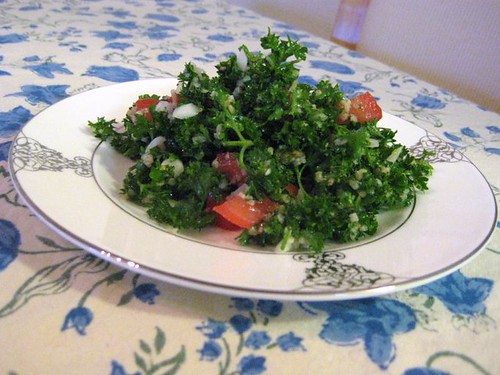This is the beginnings of a series of kubba posts. My goal is to include detailed recipes, illustrated instructions, and possibly even video demos to make the whole process more transparent. I'll add info here, then post the recipes one by one as they're ready for human consumption.
History of Kubba (interview with my father-in-law, December 2007).
Kubba came to Iraq during the Assyrian dynasty. An Assyrian empirical palace library was discovered dating back to about 2500 years ago, in which were found books referencing the king's palace and a big banquet that was held at which kubba was served. All the most wealthy and powerful individuals in the empire were invited to be the king's guests, and the price of admission was steep (yes, they paid to attend). The purpose of the banquet was to identify the high rollers who needed to pay more taxes, but the invitees didn't know that until they arrived with their admission fees and thus proof of their affluence. Gulp! Kubba kbebo was the variety of kubba served and a recipe was included. It contained wheat, boiled, crushed and mixed with meat.
When tomato came from the New World, it was added to sauces made for kubba. The invading Mongols brought sweet and sour things from China. My father-in-law thinks (but acknowledges that it's pure speculation) that perhaps this is when sweet kubba originated.
Additional notes: Basterma is undoubtedly from the Mongols, particularly the variety with spices on top. Dolma is Armenian, not Turkish, but the Turks adopted it.
Kubba Tradition (interview with my mother-in-law, December 2007)
Kubba Khaesi (Kubba in sweet apricot sauce) is a special and complicated dish eaten on happy occasions like New Year's Day and when newlyweds return from their honeymoon. Since the setting where it is eaten is so specific, it's usually only prepared a couple of times a year. This sweet variation of the adored kubba dish is well-loved by Maslawis (the locals of Musul, in northern Iraq). Can be eaten as a meal on its own (for instance if a couple is celebrating New Years by themselves), but is usually served as part of a celebratory meal with friends and family.
Accompaniments for sweet kubba
Chicken and turkey, both stuffed with rice, meat, and nuts such as chestnuts, pine nuts or almonds; white basmati rice, hummus, salad, eggplant, fasoulyah beytha or potato curry, or a vegetarian curry
Sweet Kubba Sauce
Boil the lamb bone. When it is cooked, add the rest of the ingredients. Lemon juice goes in at the end.
Ingredients
lamb bone
date syrup
figs
dry apricot
raisin
juice of half a lemon
almonds
salt and pepper
Directions
Make a rich, syrupy sauce (but not a thick one). When the flavor is right, drop the kubba in and boil until they rise to the top. Reduce heat to low and simmer for 20-30 minutes.
Other Kubbas
Kubba Hamuth (sour Kubba) is eaten whenever the urge strikes; no special occasion required. Same with kubba yachni (also called kubba hummus), made with chick peas.
Saturday, December 29, 2007
Friday, May 11, 2007
Tabbouli Tonight

2-3 bunches fresh parsley
1 bunch fresh mint
Juice of 2-3 fresh lemons
2-3 big tablespoons #2 bulgur
1/8 tsp red pepper
¼ tsp black pepper
Salt to taste
½ cup extra virgin olive oil
½ medium onion
1-2 tomatoes
Step 1
Up to 2 days before serving, triple wash, air dry, and trim the stems off of the parsley and mint. You can air dry the parsley uncovered in the fridge for an hour or two; just don’t forget about it because it will dry out in there (who knew?). Once it’s dry, if you’re not going to serve it today, place the herbs into a big Ziplock to maintain freshness until you’re ready to finish the tabbouleh.
Step 2
Between 1-6 hours before serving, in a small container, combine lemon juice with bulgur, red & black pepper, and salt. Cover and store in the fridge until just before serving.
Step 3
After step 2 and before things get too crazy in the kitchen, mince the onions, mint & parsley. Now, the best wives will shun the food processor in this step, but I won’t tell if you won’t. I’ve even used scissors to speed this step up. If you use the food processor, start with the onions, then add the mint and parsley. Warning: the food processor will increase the sogginess and decrease the texture of the tabbouleh, so be advised if you choose this route. Or you could do it the old-fashioned way and chop chop chop to your hearts' content.
Step 4
Right before serving, generously douse the parsley with olive oil. Chop and add the tomatoes. Pour (or dump) the bulgur dressing over all and combine.Garnish with hearts of Romaine lettuce and serve right away.
Kitchen Kibitzing: Back in Burbank, CA, we lived about 30 yards away from a fantastic little Middle Eastern/Armenian produce co-op where we got 6 bunches of parsley or two bunches of mint for one measly dollar. Imagine! I loved that such cheap and fresh ingredients were so readily available while I was in the learning stages of the terrific new recipes that make my husband feel at home and adored. His face lights up like Dodger Stadium when he finds this on the table. I love that I can put a smile on his face and inspire him to brag on me so easily, too. Tabbouleh has a reputation for being labor-intensive, but I’ve included some planning steps that should break it down into manageable chunks. As always, modify everything to your family’s tastes & schedules. Just remember, one never knows where an evening that begins with tabbouleh will end up!
Subscribe to:
Posts (Atom)